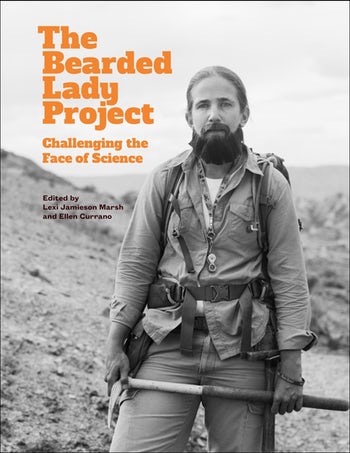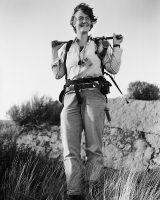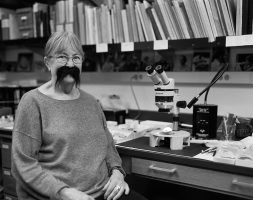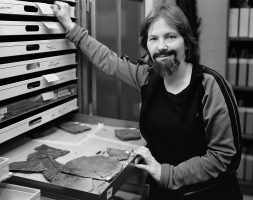It’s Not About the Beards
By Lexi Jamieson Marsh

“The Bearded Lady Project is a necessary novelty. It’s snarky, beautiful, and increasingly powerful in the evolution of its message: Don’t ever assume you know what a scientist looks like. These essays—critical, poignant examinations of societal and historical perceptions of genius—remind us how much scientists have to say about the world in which their research takes place.”
~Emily Graslie, chief curiosity correspondent at the Field Museum of Natural History
Women in science are often not taken seriously by their colleagues, a notion filmmaker Lexi Jamieson Marsh and paleobotansist Ellen Currano set out to change in The Bearded Lady Project: Challenging the Face of Science. Using a healthy dose of humor, Marsh and Currano use a simple prop, fake facial hair, to dismantle the persistent gender biases in the sciences. In this guest blog post, Marsh describes the origins and purpose of this project.
Make sure to enter our Women’s History Month giveaway for a chance to win a copy of this book!
• • • • • •
The Bearded Lady Project began as a joke, a simple moment of levity between two good friends. But what began as a bit of good natured humor evolved into a major project —one that has toured the country and caught the imagination of thousands.
The Bearded Lady Project includes a short documentary film that expanded into a second, feature-length documentary film; a touring portrait exhibition (currently on display at the Smithsonian’s National Museum of Natural History); and now a book. The publication of The Bearded Lady Project by Columbia University Press has provided this project with a unique opportunity to help our diverse audience contextualize the gender gap within paleontology, the “elephant in the empirical room….”
It was never really about the beards.
This book represents a beautiful collaboration between art and science. It includes 54 of the stunning bearded portraits taken by photographers Kelsey Vance and Draper White. The photographs are a tongue-in-cheek take on the public assumption of what a scientist should look like.

Marieke Dechesne, Hanna Basin, WY
Photo Credit: ©Kelsey Vance
Many of the beards are made of real human hair. They are meant to look authentic, but not necessarily realistic for each subject’s face. When you look closer, it’s obvious that these are costumes, not meant to make the subject look like a man. Everything, from the tools to the clothing, was chosen by the scientist. You see her as herself, with one small addition. Do you have different assumptions about what she can and cannot accomplish based on the way she looks—based on the appearance of facial hair?
In one particular portrait, that of Dr. Carole Hickman, she specifically requested to use her own mustache. When we asked her about it, she said, “This is the mustache I wore while I was working in the field in the 1970’s. I did it so I wouldn’t draw attention.”
For many of the featured scientists, an interest in paleontology started with their appreciation for the great outdoors. It makes sense that a majority of the photographs highlight the variety of landscapes where fossils are found. Picturing women at work is what we hope to normalize. Additional candid photographs document the scientists hard at work in their respective labs and field sites.

Carole Hickman, University of California Museum of Paleontology
Photo Credit: ©Kelsey Vance
The conversation within the book is constructed around the narrative of the project itself. Divided into three sections (“Stereotype,” “Women,” and “Gender”), the conversations about the project are directed toward a deeper understanding of the work being done by the scientists and the contributions of women paleontologists.
“Combatting stereotypes requires recognizing them so that we can change the surrounding settings or change individual minds. The pictures in our heads that reflect traditional images may still come forth, unbidden, especially when we are tired or busy. But with awareness we can pause the process, ask further questions, and behave in ways that reflect the values we want to uphold.” -Dr. Amanda Diekman
But what of the contributions made by women paleontologists? Who are the women working in the field? What discoveries have they made, and whose work pushed the science forward—Where is their place in the history books? Where are their photographs? Dr. Ellen Currano addresses this specific issue in a chapter titled “The Lost Legacy.” Specifically, Currano credits the individual contributions of scientists Marry Anning, Winifred Goldring, Yusra, and Annie Montague Alexander.
Individual essays from The Bearded Lady Project subjects give voice to the personal experiences that have long been internalized. Women scientists from a variety of ages, races, and backgrounds join together in sharing their experiences of what it has been like to pursue the dream of becoming a paleontologist. The voices of the authors are amplified by the stunning black and white portraits, where everything in the frame is about the subject and her research.
“In my case, fitting in was also a matter of being inconspicuous and avoiding attention. It was useful not only when working alone, but also on otherwise all-male scientific expeditions and post-conference field excursions where we shared the same experiences, got grubby, and needed lots of pockets and sometimes very large backpacks for specimens.”- Dr. Carole Hickman
Now for the key question: why put on a beard? Well, it’s all part of the discussion. During one revealing moment during the Q&A at the University of California Berkeley, one of the first questions asked was by a male faculty member: “If you want to celebrate women in science and challenge stereotypes, why put beards on them? Why not just photograph them as themselves?” Without missing a beat, Dr. Cindy Looy, a paleontologist photographed for this project and the sponsor for the UC Berkeley forum, stood up and said, “If we were not photographed with beards on, none of you would be here.” She was unflinching in her position and identified precisely the “hook” of the project.

Cindy Looy, University of California Museum of Paleontology
Photo Credit: ©Kelsey Vance
“I know, have felt overlooked, pushed aside, and ostracized by male colleagues. For these reasons, my hope is to be a role model, supporter, and ally to all marginalized groups in our field, especially now as a senior scientist. We have much work to do as a community, but I think we are moving toward a place where we can take off the beards for good.” -Dr. Sara B. Pruss
The Bearded Lady Project aims to further the mission of the women in science. If women are excluded from the narrative and provided no space, we’ll need to insert them into the world, altering who they are to conform to societal expectations. Maybe then, when we take it just one step too far, once the beard is put on, there will be an honest discussion about why diversity in science matters, and what, realistically, needs to be done to fix this problem.
It’s not about the beard.
Explore more from our celebration of Women’s History Month on the blog and stay tuned this week for an excerpt from The Bearded Lady Project.






